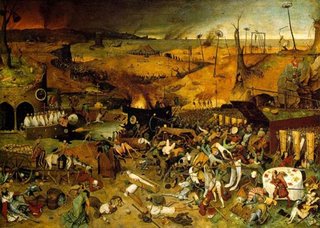THE TRIUMPH OF DEATH by Pieter Bruegel the Elder

The Triumph of Death by Pieter Bruegel the Elder. (1562)
Oil on Panel
Museo del Prado, Madrid
The painting is a panoramic landscape of death: the sky in the distance is blackened by smoke from burning cities and the sea is littered with shipwrecks. Armies of skeletons advance on the hapless living, who either flee in terror or try vainly to fight back. Skeletons kill people in a variety of ways - slitting throats, hanging, drowning, and even hunting with skeletal dogs. In the foreground, skeletons haul a wagon full of skulls, and ring the bell that signifies the death knell of the world. A fool plays the lute while a skeleton behind him plays along; a starving dog nibbles at the face of a child; a cross sits lonely and impotent in the center of the painting. People flee into a tunnel decorated with crosses whilst a skeleton on horseback slaughters people with a Scythe. The painting clearly depicts people of different social backgrounds - from peasants and soldiers to nobles and even a king - being taken by death indiscriminately.
The painting serves a useful historical purpose in that it shows aspects of everyday European life in the mid-sixteenth century. Clothes are clearly depicted, as are pastimes such as playing cards. Uniquely, the painting shows a common method of execution for sixteenth-century criminals: being lashed to a cartcheel mounted on a vertical pole. Objects such as musical instruments and an early mechanical clock and scenes including a funeral service provide historians with a deeper understanding of the lifestyle of the 1560s.
Unlike his predecessor, Bosch, Brueghel's hordes are composed of skeletons, not demons, suggesting a distinctly atheistic pessimism, and one untempered by any belief in Heaven.


<< Home